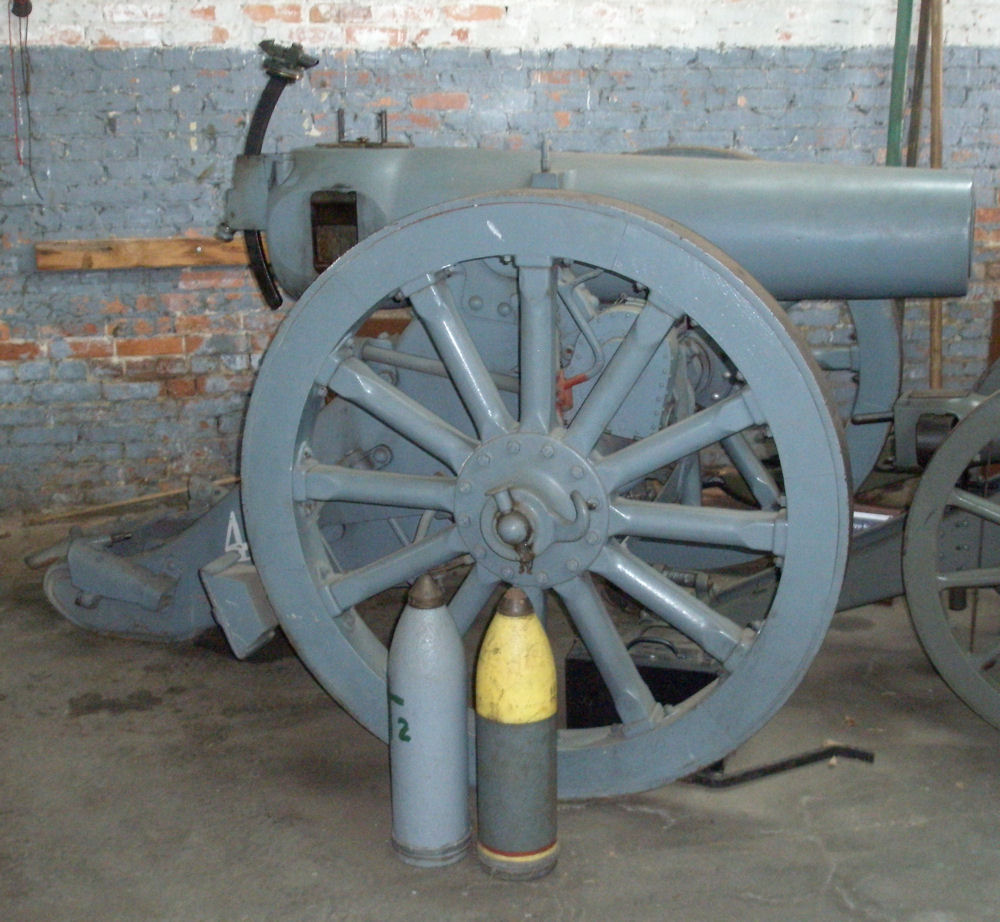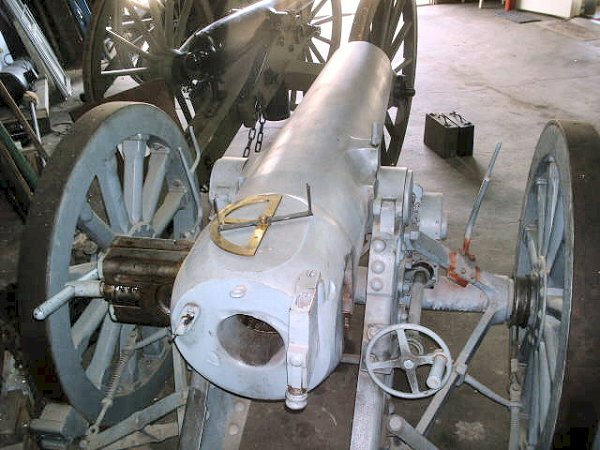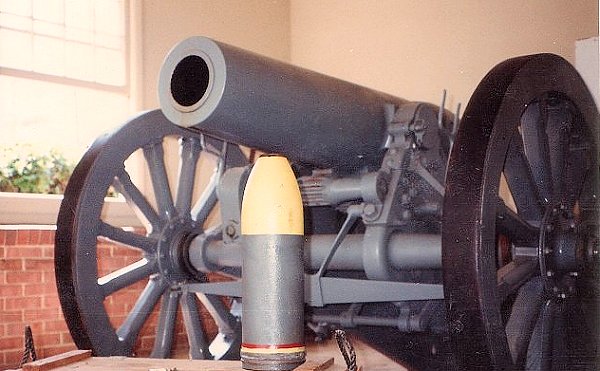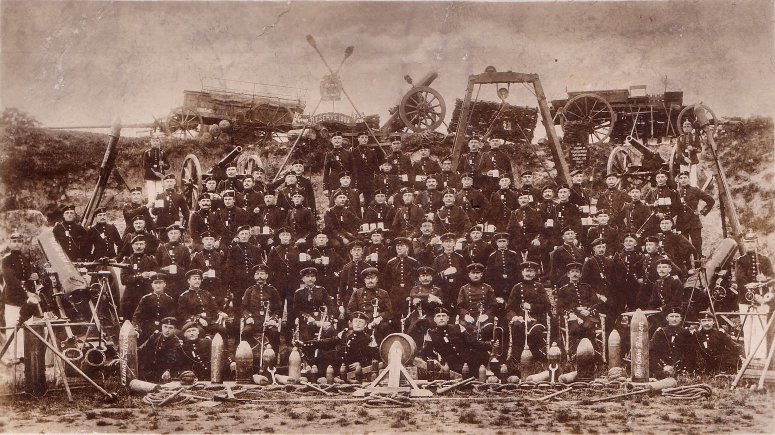The s.F.H. 93 was produced by the Krupp firm using nickel steel. This early use of steel gave, for the first time, large caliber artillery mobility enough to accompany maneuver forces and support them. Previously, large caliber heavy artillery was so heavy that it generally had to be transported in pieces and reassembled once in place or simply had a bore diameter and shell weight too small for effective service. This did not lend itself to timely or effective fire support for the infantryman in direct contact with the enemy. Consequently, heavy or Foot Artillery was either relegated to the fortress or to siege operations. In other words, Foot Artillery’s only niche was where maneuver warfare ended. Only with the advent of the 15cm. s.F.H. 1893 did Foot Artillery move into the maneuver support role, familiar to us today.
 |
This 15cm s.F.H. “93 was the first piece acquired by the Lovett artillery collection in 1981. Ralph Lovett completed the ground up restoration in 1987. The projectiles pictured with are Gr.12 types. This was one of the most common and effective projectiles in service with the 15cm. s.F.H. design series.
 |
In this photograph, the 0-5800 scale indirect fire sight is fitted to the breechring of the 15cm. s.F.H."93. The sightmount to the right side of the breech face carried a 0-5760 scale sight and arch simular to the s.F.H."02. This system was later fitted to the howitzer. The 0-5800 sight (Richtkreis) is common to all howitzers in the s.F.H. series and is carried on three pegs on the top of the breechring. It served after the introduction of the newer 0-5760 sight as a secondary or back up sight.
 |
Development of the 15cm. s.F.H. 1893
(by Ralph Lovett)
As early as the 1880’s the German General Staff saw a need for a field mobile heavy howitzer. This may seem an obvious conclusion today but this early development had few counterparts. The concepts of land warfare were well established concerning artillery employment. Light field artillery was part of a division’s organization. It provided swift moving, direct fire support to the infantry and cavalry. If battlefield maneuver ended and one side was bottled-up in a fortress or city, then siege operations began. This was the niche for heavy artillery of the army corps. It was used by the force conducting defensive operations as fortress artillery and by the force conducting an offensive as a means to attrit and break through. No nation typically used heavy howitzers as a normal part of a maneuver organization or incorporating it into their field tactics. The siege of Plewna in the Russo-Turkish War (1877-78) was an incident in which Turkish Infantry was able to take cover behind the breastworks where they were immune to the flat trajectory of the Russian Field Artillery. It was generally believed that if the Russian Infantry assault had been supported by continuing fires form heavy mortars they would have met with greater success.1 This gave a tangible example to Russian and German heavy howitzer advocates. As a result of this catalyst, in Russia a heavy field mobile howitzer design evolved, designated 6-inch Field Mortar Model 1886. First steps toward a new design in Germany took existing 12cm’s and 15cm’s, which were fitted on high carriages, and required firing foundations. These types were not suitable for anything more than siege artillery operations and were viewed with great disdain by maneuver commanders. Despite this, they could serve to test projectiles and help determine minimum requirements for this new generation of heavy artillery for the field. On 6 December 1888 the “General-Artillerie-Komitee” was nominated by the “Allerhoechste Kabinettsordre” to review results of tests conducted with these weapons. In addition the General-Artillerie-Komitee was ask to decide weather a new short 12cm gun should be introduced to fulfill this new requirement for the Field or Foot Artillery. In October 1888 the General-Artillerie-Komitee and the “Artillerie-Schiessschule” conducted firing tests and found 12cm’s insufficient when used against entrenched infantry targets.2 It was at first thought that new projectiles with high explosive would sufficiently improve this performance and might even make heavy indirect fire artillery unneeded because of the greater effects expected from lighter field guns using HE ammunition. However, because no date could be fixed for the introduction of HE ammunition, tests resumed with the short 12cm gun.3 These new tests emphasized the importance of effects on infantry dug in with cover. Also, because of the inability of the 12cm gun to meet these requirements, test were continued with 13.5cm, 15cm and 17cm howitzers. Tests proved that only a 40-kg projectile with an explosive charge of 10 to 12 kg was able to penetrate thicker improvised covered trenches.4 Such a large explosive charge could not be placed into a 13.5cm projectile, since too great a projectile length would have affected accuracy.5 It was found that the 15cm best corresponded with the requirements and on 8 May 1891 was the howitzer caliber selected by the APK. In that same year Krupp was awarded a contract by the APK to design a 15cm howitzer suitable for field operations, with a minimum range of 5000 meters and a travelling weight no greater than 2,800 kg. The resulting product was a howitzer made of nickel steel designed by Direkor Gross of the Krupp Engineering Department. This “new” steel was stronger and lighter, making barrel weight low enough to be practical for field use. Carriages were supplied for testing by Krupp and Spandau. Advances in metallurgy by Krupp were fundamental to the practicality of field mobile heavy artillery. Previous heavy pieces had simply been too cumbersome to support typical maneuver needs. Ultimately the Spandau carriage was selected because of its lesser weight along with the Krupp howitzer barrel.6 In field trials, what would become known as the s.F.H. 15cm proved successful. It was shown that the s.F.H. could be transported by a driver-team of six heavy horses. Firing platforms were found to be unnecessary, however, cane mats were often used to keep the wheels from bogging into the earth recoil-after-recoil. For prolonged stays in a firing position, wooden recoil wedges were brought up and placed to the rear of the howitzer. These wedges both took up the recoil and made the task of manhandling the howitzer back into position easier.
Differing from Field Artillery, which used the mil scale (0-6400), this weapon was fitted with a non-optical indirect fire sight graduated from 0-5800 and was years latter fitted with an optical “dial” sight graduated from 0-5760 (one sixteenth of a degree). These sights allowed the s.F.H. 15cm to be “laid” or made parallel by a single “aiming circle” or "director". The latter aiming circle was capable of magnetic laying with a removable compass also graduated from 0-5760. Forward observers, many kilometers down range, could spot targets and convey a call for fire, using, a field phone like device fitted with a loudspeaker. A fire direction control officer worked the call for fire as a geometry problem for “deflection” or azimuth and a physics problem for “quadrant” or elevation. In the fall of 1900, after watching a live fire exercise of the Foot Artillery Guards Regiment near Munster, Kaiser William II, in his analysis particularly stressed the rapid emplacement by the Foot Artillery and its effectiveness. In order to acknowledge good performance and a changed perception of it s use, the 15cm howitzer was named “schwere Feldhaubitze” (s.F.H. or Heavy Field Howitzer) by the AKO on 6 September 1900.7
The s.F.H. is an important milestone in troop development and its organization as the heavy field artillery. Gone were the days of heavy siege guns being implaced with rented horses and hired drivers, and prolonged constructions before the opening of fire. This concept of quick moving infantry and cavalry forces directly supported by heavy field mobile artillery did not meet with popular acceptance among maneuver commanders, who saw heavy guns as a burden that would slow the speed of advance. This radical change had to be forced by dedicated officers who gained support for this new technically advanced arm of service from the highest levels of government. On 15 August 1900 William II addressed troops of the Tenth Army Corps on the Munster drill field, stating , “ We must apply all means that make possible for us a successful offensive. To that end the heavy artillery of the field army will and the (maneuver commander) will make himself guilty of a neglect of duty (who does not use heavy artillery).” 8 The s.F.H. in this respect served to introduce the concept of modern heavy artillery in support of maneuver forces which can be seen even today in practice with the M109A6 Paladin.
Despite the argument that this breech loading, indirect fire s.F.H. 15cm was among the first modern heavy field artillery pieces; two major improvements remained unfulfilled. The s.F.H. has no recoil mechanism. It is a friction primer fired weapon. Its rate of fire is low because it is necessary to relay after each firing. The next production howitzer to replace the s.F.H. would to the average on looker appear much like a World War II weapon.
(See the "Development of the German 15cm." page for more information and the foot notes.)
 |
Above: This photograph was likely taken during the 1903 Kaiser's Birthday celebration. The unit is 10 Foot Artillery Regiment Reserve. 15cm. s.F.H 1893 models are seen to either side of the group and one center top. The other smaller pieces are the model 9cm. C/73 Kanone (gun) also produced by Frederick Krupp. The 9cm gun was both a Field and Foot Artillery piece with good mobility but lacked the shell weight and high trajectory fire capability of the s.F.H.